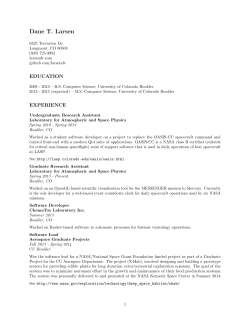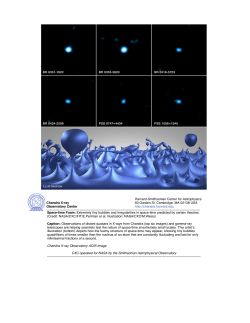
U.S. Space Policy Choices
U.S. Space Policy Choices 2nd Annual IPN Conference Arlington, VA May 18, 2015 2015 Dr. Scott Pace George Washington University Elliott School of International Affairs 1957 E Street, NW - Suite 403 Washington, DC 20052 space1@gwu.edu (202) 994-7248 1 U.S. National Space Policy • Recognizes three distinct sectors of space activity: • National Security (military, intelligence) • Commercial (satellite communication) • Civil (including both scientific research and services such as weather forecasting) • The functions performed by each can be organized along a spectrum, depending on whether they are driven by government or markets Satellite Communication (Commercial) Public Safety (Civil) 2 Space-based Weapons (National Security) Space Surveillance & Orbital Debris • Approximately 21,000 objects larger than 10 cm being tracked in 2012 • Collision Avoidance for the International Space Station and other major assets • Surveillance of Asteroids & Comets for science and warning – “potentially hazardous objects” • NASA estimated over 35,000 pieces of orbital debris larger than 1 cm from 2007 China ASAT test 3 4 GPS enables a diverse array of applications Space Applications Power Grids Surveying & Mapping NextGen Precision Agriculture Transit Operations Disease Control Intelligent Vehicles Personal Navigation TeleComm Trucking & Shipping Oil Exploration Fishing & Boating Spectrum, Computers, and PNT Source: Jules McNeff, 2010 6 Space Service Volume: Using GPS Beyond LEO and up to GeoSynchronous Altitude • 3,000 to 8,000 km Altitude – Four GPS signals usually available simultaneously, however poor geometry & coverage gaps cause harm – 1 meter accuracies still feasible, however space GPS receivers have more difficulty processing signals – GPS performance degrades with altitude due to geometry and classic near/far problem • 8,000 to 36,000 km Altitude – Users will experience periods when no GPS satellites are available – Point Positioning no longer available – Nearly all GPS signals received over limb of the Earth – High variability in signal strength and beam paths – Received power levels are weaker than those in TSV or MEO SSV – Side Lobe processing needed – Specially designed receivers will be capable of maintaining accuracies ranging from 10100 meters depending on receiver sensitivity and local oscillator stability 7 7 Why is the Space Service Volume Important? SSV specifications are crucial for providing real-time GNSS navigation solutions in High Earth Orbit • Supports increased satellite autonomy for missions, lowering mission operations costs • Significantly improves vehicle navigation performance in these orbits • Enables new/enhanced capabilities and better performance for future missions, such as: Improved Weather Prediction using Advanced Weather Satellites Space Weather Observations Astrophysics Observations En-route Lunar Navigation Support Formation Flying & Constellation Missions Closer Spacing of Satellites in 8 Geostationary Arc Key Governance Documents for NASA National Aeronautics & Space Act of 1958 P.L. 85-568 July 1958 National Space Policy June 2010 Augustine Commission 2009 National Academy of Sciences Reports NASA Authorization Act of 2010 P.L. 111-267 Annual Appropriations National Aeronautics R&D Policy – Update? December 2006 Annual Budget Requests NASA Strategic Plan 10 11 NASA Enacted and President's Budget Requests 24000.0 FY1992 NASA Budget in 2014 dollars 23000.0 Millions of Current Year Dollars 22000.0 21000.0 Enacted Budgets FY2010 NASA Request FY2011 NASA Request 20000.0 FY2012 NASA Request FY2013 NASA Request FY2014 NASA Request 19000.0 FY2015 NASA Request FY2016 NASA Request 18000.0 17000.0 16000.0 2006 2007 2008 2009 2010 2011 2012 2013 Fiscal Year 2014 2015 2016 2017 2018 2019 2020 Multi-lateral Cooperation Examples • • • • • • • • Spectrum and GEO slots - ITU Weather prediction - WMO Environmental monitoring - GEO Missile proliferation and export controls - MTCR Orbital debris and long-term sustainability – COPUOS International Space Exploration – GES/ISECG/ISEF Space situational awareness - SDA? Space communications standards - CCSDS/IOAG . DTN contributes to science, security, commerce, international cooperation and public engagement Space Entrepreneurs Bigelow Aerospace SpaceX Planetary Resources 16 Virgin Galactic Public and Private Sector Space Revenues 1. Ground terminal and Equipment 2. Direct-to-Home Television 3. U.S. DoD Space 4. Satellite Services (FSS & MSS) 5. NASA 6. ESA 7. Commercial Satellite Manufacturing 8. Russia 9. Japan 10. China 11. Satellite Radio 12. Earth Observation 13. Commercial Space Launch 14. India 15. NOAA 17 Space Foundation Report 2012 Global Space Trends • Growing Private Sector Space Investments and Capabilities – Small satellites – IT and data drivers • A Changing Space Industrial Base – Globalization • Space Governance – Increasing number of State and non-State actors – Integration vs. Fragmentation • Threats to Competitiveness – Supply Chain Dependencies • RD-180, Pu-238 – Regulatory Burdens • Commercial licensing, esp. remote sensing • Space spectrum protection, esp. 1-3 GHz • Federal Acquisition Systems – Instability in Civil Space Cooperation • Post-ISS uncertainty • Threats from Foreign Counterspace Capabilities – China, Russia, others? Excerpts from Senate Testimony, February 2015 • International space cooperation, space commerce, and international space security discussions could be used to reinforce each other in ways that would advance U.S. interests in the sustainability and security of all space activities. At present, however, these activities are largely conducted on their individual merits and not as part of an integrated national strategy. • The next steps beyond low Earth orbit will require international partners for practical and political reasons. Therefore, it makes sense to ask what our partners would like to do, and what they are capable of doing in the future. The answer is the Moon – with Mars and other destinations in the distance. A U.S. commitment now, to lead a multinational program to explore the Moon would be a symbolic and practical first step as well as a means of creating a broader international framework for space cooperation. At the same time, the geopolitical benefits of improving relations with growing space powers through greater U.S. engagement could support more ambitious space exploration efforts than science alone might justify. • The United States is crucially reliant on space systems, and the future sustainability and governance of space activities are key strategic interests for us. If we are to have an effective American space strategy, we need to align our policies, programs, and budget priorities with enduring national interests. This means looking beyond individual missions and seeking to determine what future humanity might have beyond the Earth, and what values will be part of that future. I would like those values to include the things we value today – democracy, human rights, the rule of law, and free markets. What is the Future of Humans in Space? 1. Can humans “live off the land” in space and function independently of Earth for long periods? 2. Are there economically useful activities in space that can sustain human communities in space? Nothing commercially useful Live off the land Cannot live off the land Antarctica Commercially sustainable Settlements Mt. Everest North Sea oil platform See also Harry L. Shipman "Humans in Space: 21st Century Frontiers" Antarctica • We don’t know which of these outcomes represents our long-term future. Advocates and skeptics may believe one outcome or another is most likely, but no one actually knows • Determining the actual future of humans in space would be a watershed event for the United States and humanity 20 6
© Copyright 2025





















